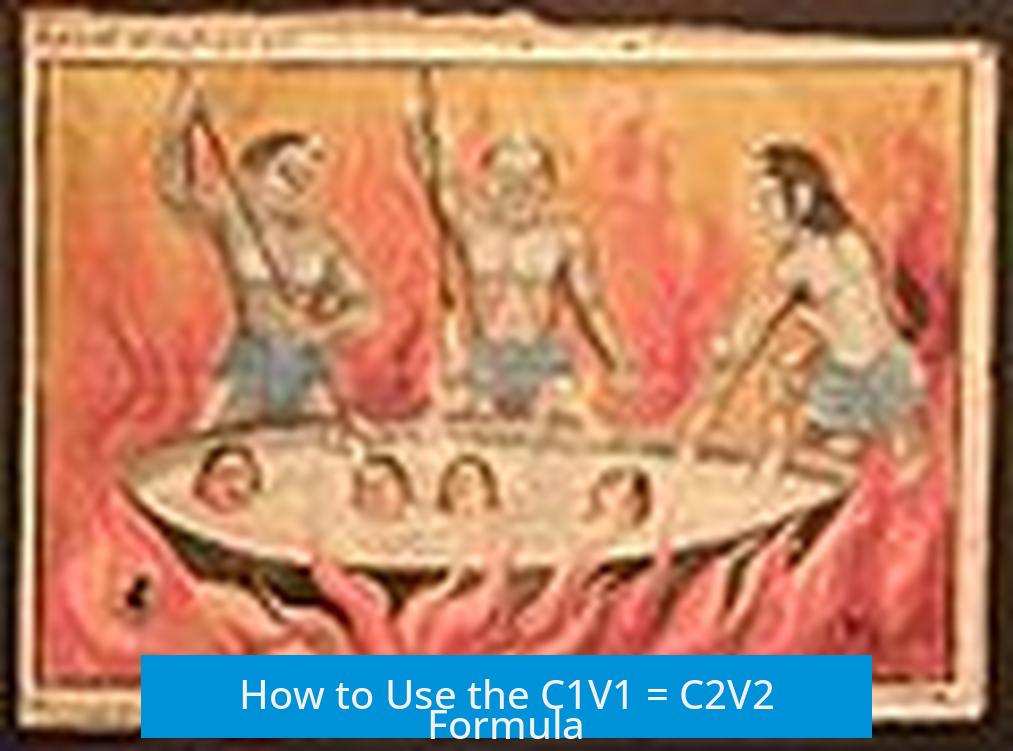How to Use the C1V1 = C2V2 Formula

The formula C1V1 = C2V2 helps calculate concentrations or volumes in dilution problems by preserving the amount of solute before and after dilution. Understanding this equation’s use makes it easier to prepare precise solutions in chemistry and biology laboratories.
What is the Meaning of C1V1 = C2V2?
The formula expresses that the product of the initial concentration (C1) and initial volume (V1) equals the product of the final concentration (C2) and final volume (V2). Since concentration times volume denotes the amount of solute, this means the amount of solute remains constant during dilution or mixing.
- C1: Initial concentration
- V1: Initial volume
- C2: Final concentration
- V2: Final volume
Rearranging the Formula to Solve for the Unknown

To use the formula effectively, rearrange it to isolate the unknown variable. Algebraic manipulation helps solve for any of the four variables depending on the problem.
- To find initial volume, V1: V1 = (C2 × V2) / C1
- To find initial concentration, C1: C1 = (C2 × V2) / V1
- To find final volume, V2: V2 = (C1 × V1) / C2
- To find final concentration, C2: C2 = (C1 × V1) / V2
Rearrangement relies on basic algebra — divide or multiply both sides equally to keep the equation balanced.
Step-by-Step Practical Example
Consider this example to see the formula in action:
- Initial concentration (C1): 1 M (1 molar) NaCl solution
- Initial volume (V1): Unknown
- Desired final concentration (C2): 0.2 M (200 mM)
- Desired final volume (V2): 0.5 L (500 mL)
You want to find out how much 1 M NaCl solution to use to obtain 500 mL of 0.2 M solution.
Using the rearranged formula to solve for V1:
V1 = (C2 × V2) / C1
Plug in the values:
V1 = (0.2 M × 0.5 L) / 1 M = 0.1 L
The units of molarity (M) cancel, leaving liters (L).
This means you need 0.1 L (100 mL) of 1 M NaCl. Add water to reach the final volume:
- Add 100 mL of 1 M NaCl stock solution
- Add 400 mL of water to reach 500 mL total
The solution now has a concentration of 0.2 M, exactly what you want.
Important Notes on Units
Consistency in units is crucial. Use the same units for volume throughout the calculation. If volumes are in liters, keep them all in liters. If milliliters, use milliliters for all volumes.
Misaligned units lead to incorrect results. Convert units before calculations as needed.
Common Uses of the Formula
- Calculate how much stock reagent to use in experiments
- Determine the concentration after dilution or mixing
- Prepare solutions at precise concentrations for chemical or biological assays
- Scale solutions up or down while maintaining solute quantity
An Intuitive Way to Understand C1V1 = C2V2
Think of concentration times volume as the amount of solute or mass in solution. That amount does not change during dilution, only the concentration or volume does.
Examples:
- Doubling concentration and halving volume keeps the same solute amount
- Multiplying concentration by 3.5 and dividing volume by 3.5 keeps solute constant
This physical concept makes the formula intuitive rather than just an abstract algebraic equation.
Summary of Key Points
- The formula C1V1 = C2V2 represents conservation of solute amount during dilution.
- Rearrange the formula algebraically to isolate the unknown variable for calculation.
- Always use consistent units—liters with liters, milliliters with milliliters.
- Apply the formula to calculate required volumes or concentrations in practical lab scenarios.
- Understanding the formula conceptually as constant solute amount aids comprehension.
How do I rearrange the C1V1=C2V2 formula to find a missing volume?
Isolate the unknown volume by dividing both sides by the known concentration. For example, to find V1: V1 = (C2 × V2) / C1. This puts V1 alone on one side, making calculation straightforward.
How can I calculate the concentration after dilution using this formula?
Rearrange the formula to solve for concentration: C2 = (C1 × V1) / V2. This helps determine the final concentration when volume changes during dilution.
Why must units be consistent when using C1V1=C2V2?
Units need to match so calculations remain accurate. For example, use liters throughout or milliliters throughout. Mixing units like L and mL can lead to mistakes.
What is the intuition behind the C1V1=C2V2 equation?
The formula shows that concentration times volume equals the amount of solute. As concentration goes up, volume goes down proportionally, keeping the solute amount the same.
Can C1V1=C2V2 be used to find any of the variables?
Yes. You can rearrange the formula to solve for any unknown: concentrations or volumes. This makes it flexible for many dilution problems and calculations.





Leave a Comment